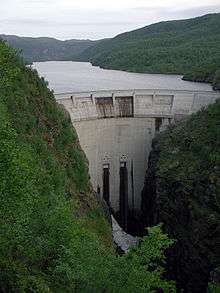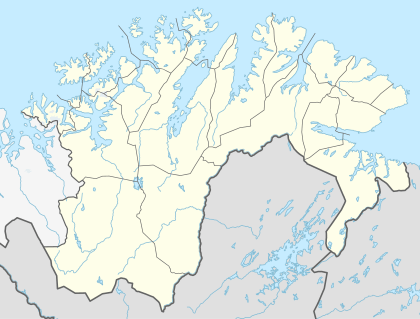Alta Hydroelectric Power Station
Alta power station (Norwegian: Alta kraftverk) is a hydroelectric power station located on the Alta-Kautokeino River in Finnmark county, Norway. The power station is located in Alta Municipality, just north of the border with Kautokeino Municipality. It is operated by Statkraft, a Norwegian state-owned electric company, and it opened in 1987.[1]
| Virdnejávr Dam | |
|---|---|
 | |
 Location in Finnmark county | |
| Official name | Alta kraftverk |
| Country | Norway |
| Location | Alta Municipality, Finnmark |
| Coordinates | 69°42′17.77″N 23°49′08.03″E |
| Status | Operational |
| Opening date | 1987 |
| Owner(s) | Statkraft |
| Dam and spillways | |
| Type of dam | Arch |
| Impounds | Alta-Kautokeino River |
| Height | 145 m (476 ft) |
| Type | Conventional |
| Turbines | 2 |
| Installed capacity | 150 megawatts (200,000 hp) (max. planned) |
The station is located 40 kilometres (25 mi) from the mouth of the Alta River, and it receives most of its water from the great Finnmarksvidda plateau. Below the power station, the river has salmon, and is a good fishing river. The station consists of two generators, at 100 megawatts (130,000 hp) and 50 MW (67,000 hp), respectively. The station utilises a 185 metres (607 ft) fall from the dam at the end of the 18 km (11 mi) long reservoir Virdnejávri. From the 145 m (476 ft) tall Virdnejávr Dam to the end of the power station the river is dry for about 2 km (1.2 mi). It is the tallest dam in the country.[2]
Controversy
The background for the controversy was a published plan by the Norwegian Water Resources and Energy Directorate (NVE) that called for the construction of a dam and hydroelectric power plant that would create an artificial lake and inundate the Sami village of Máze. After the initial plan met political resistance, a less ambitious project was proposed that would cause less displacement of Sami residents and less disruption for reindeer migration and wild salmon fishing.
In 1978, the popular movement against development of the Alta-Kautokeino waterway (Folkeaksjonen mot utbygging av Alta-Kautokeinovassdraget) was founded, creating an organizational platform for first opposing and then resisting construction work. This group and others filed for an injunction in Norwegian courts against the Norwegian government to prevent construction from commencing.
In the fall of 1979, as construction was ready to start, two acts of civil disobedience started. At the construction site itself at Stilla, a number of activists sat down and blocked the machines from starting their work; and at the same time, a number of Sami activists camped outside the Norwegian parliament, starting a hunger strike.
The prime minister at the time, Odvar Nordli, pre-empted such an escalation by promising a review of the parliament's decision, but the Norwegian parliament subsequently confirmed its decision to dam the river. More than one thousand protesters chained themselves to the site when the work started again in January 1981. The police responded with large forces, and at one point 10% of all Norwegian police officers were stationed in Alta and quartered in a cruise ship. The protesters were forcibly removed by police.
For the first time since World War II, individuals were arrested and charged with violating laws against rioting. The central organizations for the Sami people discontinued all cooperation with the Norwegian government. The Supreme Court ruled in favor of the government in early 1982, at which point organized opposition to the power plant ceased, and the power plant was built.[3]
See also
References
- Store norske leksikon. "Altaelva" (in Norwegian). Retrieved 2013-01-14.
- "Norsk Dambygging" (PDF) (in Norwegian). NTNU. 22 October 2013. Archived from the original (PDF) on 6 May 2014. Retrieved 5 May 2014.
- Store norske leksikon. "Alta-saken" (in Norwegian). Retrieved 2013-01-14.